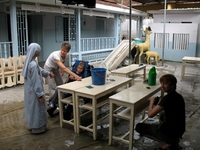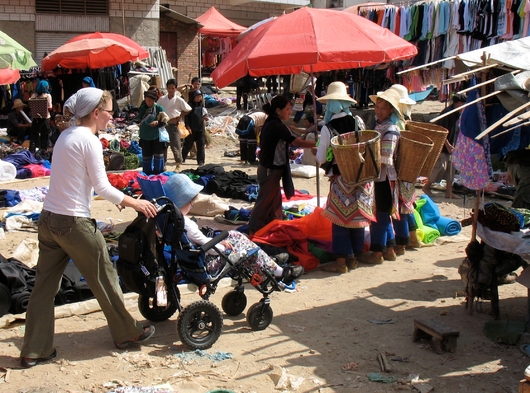A Family’s Remarkable Hands-On Journey Through Southeast Asia
The Vietnamese orphanage run by Buddhist nuns didn’t have a volunteer program, but they appreciated our offer to help and welcomed us openly. We spent our first morning playing games and singing songs with the children. Then, we were served a special lunch of vegetarian delicacies. After helping to wash dishes (over 200 children live at the orphanage) in huge aluminum basins filled with cold well water, we were shown to a room with beds so that we could take a nap like everyone else in the orphanage. This was not what we expected.
Volunteering while on a trip was new for our family. While we had travelled extensively within Canada and overseas, this would be more than a vacation. During our time in Southeast Asia, we wanted to do more than be passive observers. We wanted to participate in the culture and to contribute in some way.
Despite the challenges that we realized we would face travelling with a wheelchair user, we had always vowed that our 12-year-old daughter Kasenya’s cerebral palsy would not interfere with our passion for travel. And my husband and I knew the benefits that travel would bring Kasenya and our 15-year-old son, Devin: greater tolerance, flexibility, adaptability and an education.


Our four-month trip to Southeast Asia took us to Beijing, the remote southern region of China, Vietnam, Laos, Saigon and Cambodia. Southeast Asia is all about juxtaposition: crowded cities choked with exhaust fumes against pastoral countrysides; the pungent smell of garbage and warm sea breezes; aggressive hawkers and quiet heroes; abject poverty and cellphones; violent histories and peaceful Buddhist temples.
In planning this trip, we decided to backpack and use local transportation as we didn’t want to blur through villages on a bus between tourist attractions. Volunteering was another way that we hoped to see things that are not typically accessible to tourists. We spent hours on the Internet searching for small organizations that met our criteria of being local initiatives and not requiring us to pay to volunteer.
Our first volunteer experience at the orphanage was organized through the Office of Genetic Counseling and Disabled Children in Hue, Vietnam. On our second day at the orphanage, we cared for the babies in the nursery. At lunch we helped the teachers, since many of the children required assistance with feeding. Then, we were presented with buckets and rags so that we could clean classrooms.
We hauled the desks into the courtyard, giving a wet rag to Kasenya and wedging her wheelchair under a desk so that she could wash the top of it. A young nun came to me and said, “It is not good. She will get cold.” We were in Vietnam, and it was over 25 degrees outside. The nun was objecting to Kasenya working.
The environment at the orphanage was loving and almost idyllic. The classrooms were well organized and the programming resembled what you might find in Canada, complete with circle time. But the children with special needs live a sheltered life; they are spared from chores and eat separately from the other children. When we resumed our cleaning duties in the afternoon, some of the children and teachers from the special needs classes began to join us. The children giggled and splashed, even rewashing some of the desks that were already complete.
By expecting Kasenya to contribute and participate in everything we did, we had introduced a new perspective. More often than not, our biggest contribution was not from the time we volunteered but from the hope that we brought.
On a dirt road in rural Cambodia, my daughter and I were stopped by a woman who jumped off her bicycle when she saw us. We were taking a break from teaching English at Chumkriel Language School, near Kampot, Cambodia. The woman talked excitedly in Khmer. Later, she arrived at the school on her bicycle with her son on the seat in front of her, his head wobbling back and forth. A teacher translated that the boy was two years old and had cerebral palsy. Since she had never seen another child with a disability, our daughter gave this woman hope for her son.
Throughout Southeast Asia, acquired disabilities are common as people continue to be injured by encounters with landmines. At first, it is shocking and unfamiliar to see amputees begging in the street as this is the only way many can earn an income. Children with congenital disabilities are less visible, often because families lack a wheelchair to take them out. Carrying Kasenya on our backs in a homemade backpack carrier (even up hundreds of stairs from the boat to the hidden caves filled with Buddha statues in the jungle high above the Mekong River in Laos) was new for us. But carrying a child with a disability on your back is a necessity for many Southeast Asian families.
Kasenya’s blue foldable travel wheelchair was a coveted piece of equipment and a clear symbol of the difference in resources available to our family compared to those in Southeast Asia. But the difference goes far beyond having less equipment. Limited disability awareness and access to services leaves families with few supports. Children with disabilities often end up in orphanages because their families don’t have the resources to care for them. The ones who attend the program at the orphanage in Hue are amongst the fortunate few. Many children with disabilities, especially in rural areas, never get the chance to go to school.
The benefits of the medical intervention and regular therapy that Kasenya has received set her apart from children with disabilities in Southeast Asia. In a small Mekong Delta village, where we spent a week teaching English, I noticed a young boy with cerebral palsy resting in his mother’s arms in the market. Later, when I explained to our hosts that this child has the same condition as our daughter, they looked at me incredulously. How could this little boy with the emaciated body have anything in common with our robust daughter?
The Rehabilitation Department at the Children’s Hospital in Saigon is one of the few places in Vietnam that offers therapeutic schooling for children with physical disabilities. Vietnam is a communist country and “official” approval was required for our visit, but this was a minor inconvenience balanced by the general sense of safety and order that communist countries, such as Vietnam and China, offer.
A meeting was arranged with parents whose children receive services from the rehabilitation department. We expected it to be a small group, since anyone who took time off work would forego wages or income from their business.
Sixteen parents arrived. As we were being introduced, I noticed that many were weeping before we had spoken a word. I walked around and greeted each of them. Many hugged me like an old friend. In this primarily Buddhist country, bad karma is still believed by some to be the cause of disability, so meeting a family from a “rich” country with a disabled child was a moving experience for them. Our “presentation” consisted of a brief talk about our family followed by a question-and-answer session that revealed many common challenges in managing cerebral palsy.
Without the restrictions of an organized tour, we were free to explore Southeast Asia. We saw and experienced things that aren’t “on the tour,” like freshly butchered dog in the side alley off a market in China. We visited farms, schools and temples and participated in a Buddhist celebration. In a small Cambodian village, an older woman offered a black magic cure for Kasenya’s condition. Because we were approachable, we were invited into people’s homes and they extended their greatest hospitality, finest food and homemade rice whisky to us.
The food of Southeast Asia is a cornucopia of regional variations, from the spicy hot flavours of Southern China to the pepper and lime combinations of Cambodia. Water beetles, scorpions or tarantulas on a stick are available in the markets and at bus stops. Soups are a ubiquitous staple, but sometimes we didn’t know what we were eating. During one memorable meal, Devin pulled something from his chicken soup with his chopsticks and asked, “What part of the chicken is a tube?” Despite the fact that there were several possible answers, he ate it.
Because we had consciously traded away convenience for an authentic experience, the trip was at times physically grueling. We took a caregiver with us for Kasenya. We needed, and appreciated, the extra set of hands, especially when all that was available was a squatter toilet for Kasenya to use. It also allowed us time away from each other, which is necessary on a long trip. We introduced Lacey as our “friend,” since this was the least awkward way to explain her role within our family. This kind of care would have been unimaginable for Southeast Asian families.
We learned to work as a team. Each of us carried one backpack and one travel bag, and it took a coordinated effort to prevent our bags from being left behind, or stolen, while we were loading Kasenya and her wheelchair onto buses, boats and tuktuks. We walked hundreds of kilometres on dusty red dirt roads and over broken pavement. We lifted Kasenya onto planes and into taxis, folding and unfolding her wheelchair until we wore it out and had to cobble together repairs with glue and motorcycle parts to make it last for the final month of the trip.
We developed scouting strategies for finding accommodations when we arrived in new locations, because you can’t always tell from the guidebook whether a place had any accessible rooms.
We had minimal standards of accessibility and were satisfied with a room on the ground floor, which wasn’t always possible. Once, accommodation that we found on the Internet turned out to be unacceptably dirty and expensive. The only available alternative was a room on the upper floor at a hostel with no elevator. So, we each took a corner and hauled Kasenya in her wheelchair up several flights of stairs. Newer hotels in resort areas tended to have elevators, but they were intended as a luxury for ambulatory guests and, occasionally, were so small that we had to partially collapse Kasenya’s chair to get her in.
We took significant risks on this trip and sacrificed half a year of schooling and income. But the intrinsic rewards went far beyond anything we could have hoped for, as we touched others and were ourselves touched in profound and lasting ways.
Laverne Bissky is a Calgary-based writer and a speaker on the topic of living with passion, purpose and joy (www.bissky.com). She is currently working to establish a meditation retreat in Cambodia that will provide funding for an orphanage and other projects. To read more about her travels, visit www.noordinaryjourney.com.














